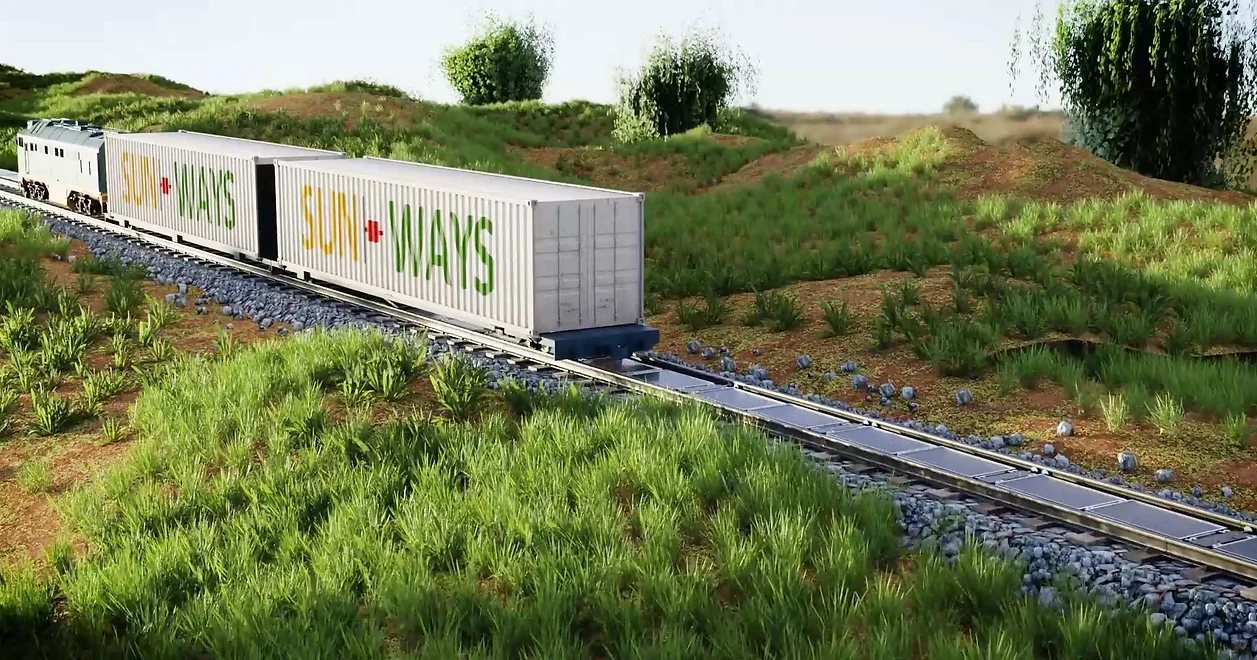(Above Photo Credit: Sun-ways https://www.sun-ways.ch/ )
Swiss startup Sun-Ways is currently planning to install solar panels along railway tracks in the country. The project’s first effort is centered around a train station near Buttes. Work is expected to start in May, pending approval from the Federal Office of Transport.
As the climate crisis and ongoing conflicts increase the need to speed up Europe’s energy transition, developers and inventors look at potentially new surfaces for generating power.
Railroad tracks are an attractive solution because they have long periods of no use while offering a protective quality between the metal rails. [1]
The technique is unique because the installation isn’t permanent. Sun-Ways created a mechanical device that deploys removable panels along the tracks. If successful, this approach to energy collection could be implemented on 50% of the world’s railway lines. [2]
Why Choose Railroads for Solar Panel Installation?
The area between a standard railroad line is wide enough to accommodate a standard solar panel without impeding train passage. Sun-Ways co-founder Baptiste Danichert says it is a practical way to start producing some of the electricity we need.
“Solar panels between rails have no visual or environmental impact,” said Danichert.
This approach makes it possible to initiate a large installation without worrying about available space. Sun-Ways uses factory-preassembled panels that get fastened to the rails using a piston mechanism. A train built by the Swiss company Scheuchzer mechanically performs the work.
As the train spreads the photovoltaic panels along the track, it looks a lot like a carpet is getting unrolled and installed.
This concept isn’t a new idea, but it is an evolution of an idea to mount photovoltaic components to railroad sleeper cars.
Sun-Ways is the first to patent a removable system. According to Danichert, that extra step is the innovation. “It allows maintenance works to remove the panels to perform rail grinding and other necessary tasks to create safe travel opportunities. Trains continue to travel along the lines without incident.” [3]
The power generated by this system would be sent to the grid to deliver energy to local residences.
The Technology Isn’t Without Potential Risks
Although installing solar panels between train rails seems beneficial in many ways, there are still some concerns about how it would perform.
According to the International Union of Railways, three potential risk factors require additional research to ensure safe use.
- There is a potential risk that the panels could develop microcracks when trains pass over them on the rails.
- Heat can be included with solar energy collection and rail friction, potentially increasing the risk of grass and forest fires by the tracks.
- Reflections from the installed panels could cause drivers to become distracted.
Sun-Ways says the technology used to prevent reflections from sunlight makes the PV panels more durable than conventional designs.
Even with the potential risks, the benefits of installing the equivalency of 760 football fields of solar panels are numerous. Estimates suggest this idea could generate 1 TWh of energy annually, which represents 2% of Switzerland’s total needs.
Sun-Ways intends to look at rail installation options in Germany, Austria, Asia, and the United States as the proof of concept expands.
“There are over a million kilometers of railway lines in the world,” Danichert said. “That means over 500,000 km of installation opportunities exist to generate renewable energy.”
Over a Dozen Partners Are Ready to Start the Project
“The biggest challenge is not technological,” said Danichert. “What we need is a mentality change in the railway sector, which is an area that’s usually not very open to innovation.”
Along with about a dozen partners and the Swiss Innovation Promotion Agency, Sun-Ways expects a successful outcome because unique solutions allow the technology to work in multiple environments.
Sun-Ways plans to have circular brushes mounted at the end of the trains to remove the residual dirt when areas have dust and debris accumulation. When low temperatures or snowfall interfere with the panels, a melting system is under development to install along the tracks.
“Several scenarios in Switzerland show that photovoltaics is the key technology to achieve the goal of phasing out nuclear power and achieving a net-zero emission balance,” said Professor Evelina Trutnevyte, an energy systems analyst and modeler at the University of Geneva that specializes in renewables. [4]
Estimates from the Federal Office of Energy in Switzerland suggest that PV systems could cover 20% of the current electricity demand by 2050.
Trutnevyte adds another potential benefit to the Sun-Ways project. She says they’re instrumental to have during an energy security crisis because they can be built relatively quickly.
The Sun-Ways pilot project is expected to cost about $450,000.
References:
[1] https://www.swissinfo.ch/eng/power-generating-railway-tracks-are-coming-down-the-line/48355960 ; [2] https://interestingengineering.com/innovation/solar-panel-carpet-on-railway-tracks ; [3] https://www.sun-ways.ch/blank-7 ; [4] https://www.unige.ch/res/group-members/evelina-trutnevyte












